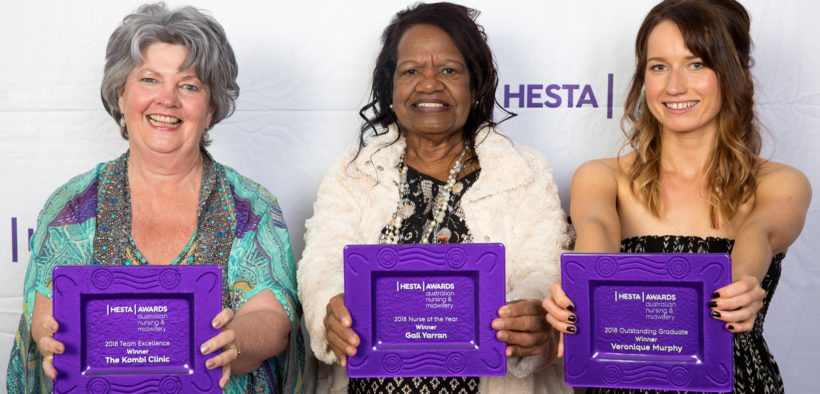Australia’s most prestigious nursing and midwifery awards have honoured three winners who have made ground-breaking improvements to the health sector.
HESTA Australian Nursing and Midwifery Awards winners Gail Yarran, The Kombi Clinic and Veronique Murphy stood out as Nurse or Midwife of the Year, Outstanding Graduate and Team Excellence respectively for excelling in their area of expertise.
HESTA CEO, Debby Blakey, said this year’s winners demonstrated commitment to the nursing profession with improvements to patient health outcomes and the implementation of innovative solutions that have advanced the standard of care.
“We are proud to recognise the winners of this year’s awards. They have shown leadership in advocating on behalf of their patients for improved access to health care whilst also providing meaningful solutions to overcome these challenges.”
Nurse of the Year awardee, Gail Yarran, was honoured for her contribution to improvements in Aboriginal and Torres Strait Islander health care and for advocating for better delivery of health services in clinical and pilot research programs.
“I’ve been a nurse for 50 years and I know I can’t close the gap, but I can do my little part to make a difference,” Yarran said.
With the $10,000 prize money, Yarran said she would be researching different cultures to find ways to improve antenatal health and make them more accessible to women. Additionally, Yarran will continue her work with The Heart Foundation in Perth.
The Kombi Clinic, a mobile medical clinic providing life-saving treatments to people living with hepatitis C across South East Queensland, was awarded for bringing medical care directly to people who are most vulnerable. The prize money will be used for new technology that will enable on the spot diagnoses.
Outreach Fibroscan Nurse Mim O’Flynn said, “The Kombi Clinic is a team of passionate people who want to eliminate hepatitis C by 2030. Our patients often haven’t spoken to anyone about their hep-C status and we offer them a safe environment and the opportunity to seek treatment free of judgement.”
“We go to areas of the community helping people that we’ve identified are of great need, this could be those who are disenfranchised or homeless, and we work in different locations like around alcohol and drug services as well as on the street.”
Veronique Murphy, Outstanding Graduate winner, was awarded for improving the care experience of patients who have difficulty communicating by developing a process to facilitate the record keeping of patients likes and dislikes.
The ‘patient preferences prompt sheet’ was designed by Murphy to ensure vital non-clinical information that could be easily communicated between staff, enabling the improvement of compassion and quality of care.
“The more we know about the patients, the more easily we can guide them through the times when they’re struggling to communicate,” said Murphy.
“I believe in holistic but person-centred care, where each interaction is modified by the nurse to meet the unique needs of the patient – and their community – [to] provide the best chance of improving health outcomes.”
Blakey said this year’s winners stood out from an “exceptional group of finalists” and their commitment to improving patient health care outcomes, “Has had a profound impact on the lives of many Australians.”
















































































































































